

DOUBLE EFFICIENCY
The Double Efficiency line had its beginnings
with the introduction of the Oil Cooled engines in 1902. It was at
this time that the large sideshaft engines were built and referred to
simply as "Open Jacket Frost-Proof." A smaller sized line of
conventional pushrod engines were also developed and for several years
became very popular.
As previously mentioned the sideshaft engines were already being built when the Double Efficiency line was introduced. Catalog 3A lists them as 8, 10, 12 and 15hp. An 18hp was soon added and finally a massive 20hp topped out the line. They featured a single piece cylinder and hopper, low tension ignitor ignition, open crankcase, vertical flyball hit miss governing and the flywheels were of a solid hub design. An overflow mixer was used fed by a cam operated fuel pump. The kickback method of starting was preferred and a special mechanism was fitted allowing the operator to conveniently trip the ignitor by hand at the proper moment. If desired these engines could be built for use with a tank cooling system and a sight glass was fitted to monitor water level in all of the hopper cooled sizes. Battery ignition was standard but a low tension magneto geared off the sideshaft was offered as was a Motsinger friction drive dynamo, batteries were used for starting with both options.
Besides the sideshaft engines two smaller pushrod engines were first included in the Double Efficiency line, a 4hp a and 6hp engine. The 6hp was actually nothing more than a hopper cooled version of the Oil Cooled engine. However the 4hp was a totally new design. It too had a single piece cylinder and hopper, featured an enclosed crankcase and split hub flywheels. It also utilized low tension ignitor ignition but featured a most unusual torsion ignitor trip system. Hit miss governing was still used with a pivoting weight being located on the flywheel. In keeping with its big brother a cam operated fuel pump fed an overflow mixer from a tank located in the sub base. It was not long before the old 6hp was dropped in favor of expanding this new design. A 3hp engine was added, the 4hp re-rated to 5hp with 7 and 9hp engines topping out the line. 5-9hp engines were equipped with a sigh glass and their flared hopper openings were separate castings. Some 3hp engines utilized a separate casting for the hopper opening but others were cast as a single piece. Again battery ignition was standard but two magneto options were offered. A low tension magneto was bolted to the top crankcase cover and driven by the cam gear via an idler. A Bosch 32 oscillating magneto was also offered and mounted on a plugoscillator bracket much like a Webster setup. This was a most unusual setup and so far has mostly been seen on export engines.
Both styles 5 to 20hp could be fitted with a kerosene attachment at additional cost. All sizes were available as stationary or portable and engines could be furnished with a variety of both plain and clutch pulleys.
As previously mentioned the sideshaft engines were already being built when the Double Efficiency line was introduced. Catalog 3A lists them as 8, 10, 12 and 15hp. An 18hp was soon added and finally a massive 20hp topped out the line. They featured a single piece cylinder and hopper, low tension ignitor ignition, open crankcase, vertical flyball hit miss governing and the flywheels were of a solid hub design. An overflow mixer was used fed by a cam operated fuel pump. The kickback method of starting was preferred and a special mechanism was fitted allowing the operator to conveniently trip the ignitor by hand at the proper moment. If desired these engines could be built for use with a tank cooling system and a sight glass was fitted to monitor water level in all of the hopper cooled sizes. Battery ignition was standard but a low tension magneto geared off the sideshaft was offered as was a Motsinger friction drive dynamo, batteries were used for starting with both options.
Besides the sideshaft engines two smaller pushrod engines were first included in the Double Efficiency line, a 4hp a and 6hp engine. The 6hp was actually nothing more than a hopper cooled version of the Oil Cooled engine. However the 4hp was a totally new design. It too had a single piece cylinder and hopper, featured an enclosed crankcase and split hub flywheels. It also utilized low tension ignitor ignition but featured a most unusual torsion ignitor trip system. Hit miss governing was still used with a pivoting weight being located on the flywheel. In keeping with its big brother a cam operated fuel pump fed an overflow mixer from a tank located in the sub base. It was not long before the old 6hp was dropped in favor of expanding this new design. A 3hp engine was added, the 4hp re-rated to 5hp with 7 and 9hp engines topping out the line. 5-9hp engines were equipped with a sigh glass and their flared hopper openings were separate castings. Some 3hp engines utilized a separate casting for the hopper opening but others were cast as a single piece. Again battery ignition was standard but two magneto options were offered. A low tension magneto was bolted to the top crankcase cover and driven by the cam gear via an idler. A Bosch 32 oscillating magneto was also offered and mounted on a plugoscillator bracket much like a Webster setup. This was a most unusual setup and so far has mostly been seen on export engines.
Both styles 5 to 20hp could be fitted with a kerosene attachment at additional cost. All sizes were available as stationary or portable and engines could be furnished with a variety of both plain and clutch pulleys.
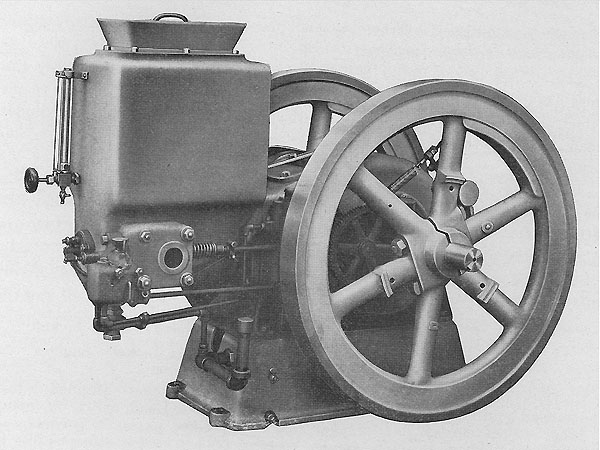
The Double Efficiency was a high quality, compact and handsomely proportioned engine.
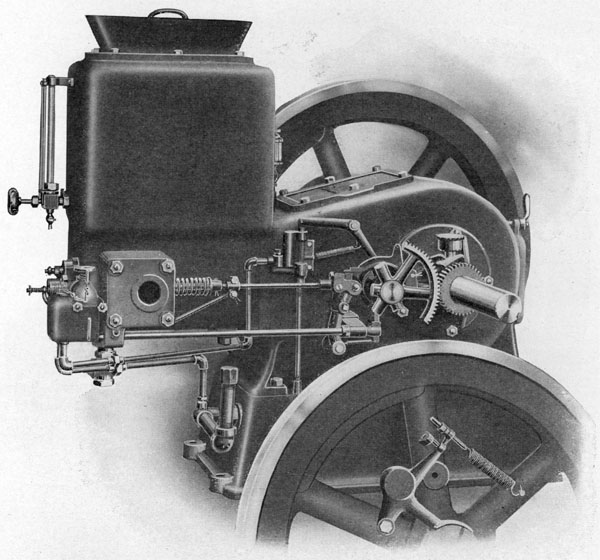
The intricate workings of the 3-9hp engines.
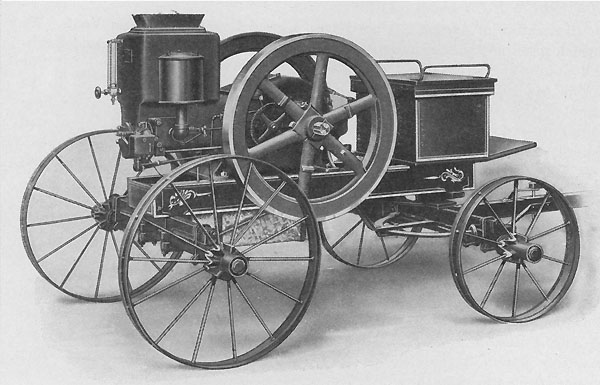
The sub base was left off for portable engines and a fuel tank mounted between the rails.
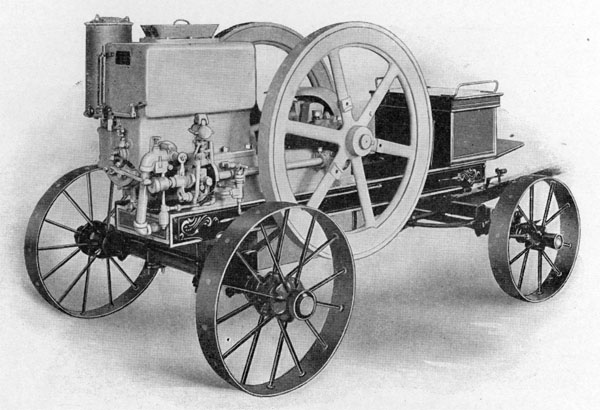
Engines for portable use were mounted on a heavy cart making for an impressive piece of machinery.
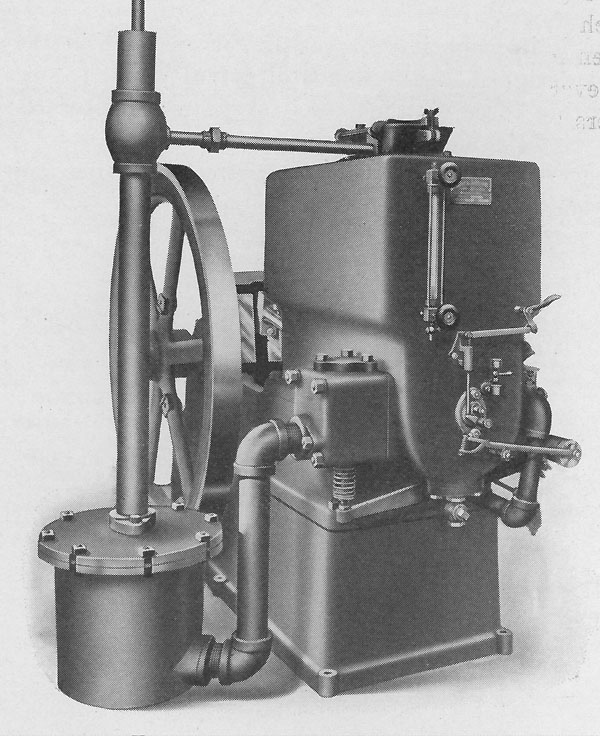
For indoor service an exhaust pot and hopper cover were supplied. Note the mechanism to manually trip the ignitor for starting.
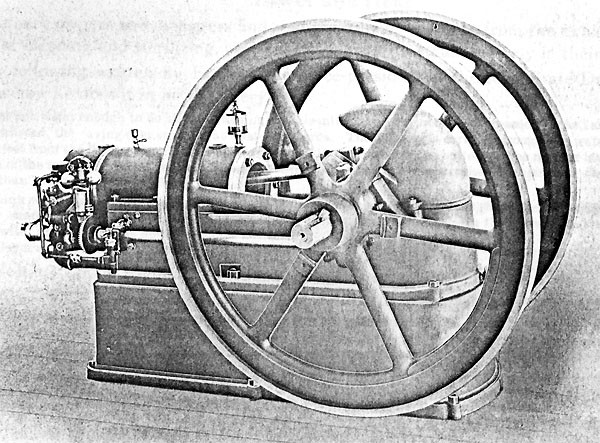
The sideshaft Double Efficiency engines were available with tank cooling like this 12hp example.
| HOME |